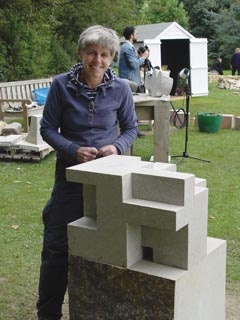Stone festival: Barnard Castle
The Stone Festival at the Bowes Museum in Barnard Castle, County Durham, was back last month (September) for a second year to spread the message of the heritage of stone in construction and carving in the North Pennines – an area the organisers describe as a hotspot of stone use. NSS joined more than 6,000 other visitors who went along to enjoy the event.
A summer of stone festivals concluded with a Festival based at Bowes Museum and that spread out into other venues at Barnard Castle, County Durham, from 21 to 29 September.
It was not like the festivals held at Gloucester, Bristol and Lincoln. It did not consist of masons and carvers competing against each other in a spirit of friendly rivalry to produce a piece of work that would be judged the best in the event.
Instead it took a rather more serious approach to presenting the past, present and future of stonework in the North Pennines, an area the organisers describe as a hotspot of stone and stonemasonry.
This was the second of the Barnard Castle Festivals backed by VAR (Vernacular Architecture Revival). The first was last year (see NSS November 2012) and was even longer than this year’s nine-day event.
VAR was established by local stonemason Peter Coverdale with Martin Clark, Peter Kempsey and Sonia Kempsey as a result of them attending the Wallington Hall Heritage Skills Fair & Conference run by Northumberland National Park Authority in association with English Heritage and the National Trust in 2005.
VAR obtained three-years’ funding from the Heritage Lottery Fund through Durham County Council’s Heart of Teesdale Landscape Partnership to research and develop a Stone Academy to create an educational infrastructure that develops stone skills and an understanding of how stone can be used in both traditional and innovative ways.
The aim is to build a the Academy ecologically out of straw bales with lime render and plaster at Peter Coverdale’s Cross Lanes farm shop and cafe, where sheep graze on the grass-covered roof.
The Festival at Barnard Castle also had the backing of Durham Creatives, a project established to support the arts and crafts in the North East, and was supported by various other local interests. It was organised by Katherine Banner and Ewan Allinson. Ewan is a freelance sculptor and dry stone waller who demonstrated walling at the Festival.
Two unrelated Paul Allisons, one of Dunhouse Quarries and the other of Sherburn Stone Company, supplied the stones used for the Festival.
Rebecca Tappin, an architect who lives locally, was one of the emerging sculptors in residence who produced a sculpture during the Festival. It is a viewer intended to frame the landscape, as if the landscape is on a postcard. It was inspired by the theme of the Festival, which was ‘landscapes’.
Another emerging sculptor in residence at the Festival was Beatrice Searle, who has been working at Mark Atkins’ company, Teesdale Architectural Stone, one of the supporters of VAR and the Festival.
Beatrice has a fine arts degree and wanted to expand into stone carving. She says the masons have given her a crash course. “I have learnt more in eight weeks than I ever thought possible,” she told NSS. Mark Atkins describes her as an enthusastic pupil who “wants to learn; is hungry for it”.
Her contribution to the Festival was a corbel carved on one side with an oak sprig to represent the English stone and on the other with a grape vine to represent the French architecture of the Bowes Museum.
The headline sculptor at the Festival was Louise Plant, an Associate of the Royal Society of British Sculptors who had made a guest appearance last year.
She said she had intended to carve something quite fluid, but when she saw the Catcastle sandstone “it had too much strength and presence; it had to be very angular”.
The Festival also included an ambitious series of talks, guided walks and courses in stone carving and lettering for adults and school children.
Afterwards, Ewan Allinson summed up the Festival like this: “Once again, the festival struck a chord with both locals and visitors. In particular, the presence of the group of sculptors hard at work in the grounds of the Bowes Museum proved a real draw.”
Louise Plant added: “This project has the potential and background to move into a much bigger vision, capitalising on the energy, creativity, skills, expertise and experiences developed and identified during the past two years.”

